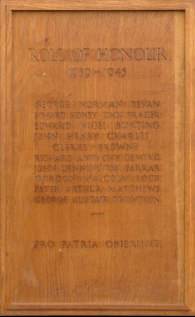The WWII Years at Aymestrey School
|
The active side of the war seemed pretty far away; though Dan Asterley and his Home Guard platoon practiced small arms firing in the wood below the front lawn, and one evening we watched with interest as Colonel Ogden cleaned his revolver just below our dormitory window. This changed briefly during a morning class when a German bomber flew across the lawn below treetop level (you could see the pilot and rear gunner clearly) to drop two bombs on the Meco works in Worcester (Thursday, 3 October 1940) before going home. Other aircraft were mostly Tiger Moth biplanes with trainee pilots learning to do loops and stalls”.
Lt Col A V Claydon (1940-44) |
|
|
_He never asked any of
us to do anything he was not ready to do himself, and he’d often get out and do
things we’d have been glad and proud to do for him. If all the officers here is like him, we’ll be all right.
|
Oliver Philpot (1925-1927) was one of the three escapers from the Stalag Luft III German POW camp through the tunnel they had dug under the vaulting horse, in the successful escape known as ‘The Wooden Horse’. He posed as a margarine executive from Norway and travelled to freedom on his own, while the other two escapers travelled together.
During the war there was an air-raid shelter in the cellar. Exeat Sundays were abandoned, as was the Old Boys cricket match – rain caused the first one after the end of the war (1946) to be replaced by a ping-pong match, an impromptu concert and sing-song. Scout camps continued.
During the war there was an air-raid shelter in the cellar. Exeat Sundays were abandoned, as was the Old Boys cricket match – rain caused the first one after the end of the war (1946) to be replaced by a ping-pong match, an impromptu concert and sing-song. Scout camps continued.
